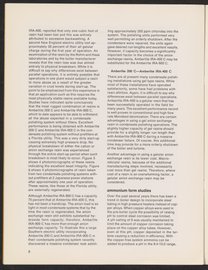Amberlite Ion Exchange Resins in Condensate Polishing
- 1968

Rights
Download all 16 images
PDFZIPof full-sized JPGsDownload selected image
Small JPG1200 x 1541px — 199 KBLarge JPG2880 x 3698px — 1.3 MBFull-sized JPG3579 x 4596px — 2.0 MBOriginal fileTIFF — 3579 x 4596px — 47.1 MBTechnical publication describing the systems of ion exchange deionization for treating boiler condensate, a major source of feedwater contamination. Proves how it is economically desirable to carry out high flow rate condensate polishing operations through the use of ion-exchange resins such as Amberlite, a high-quality resin produced by the Rohm and Haas Company for use in industrial softening applications when high performance and cost-effective operation is required. Includes photomicrographs and tables. Work is digitized in its entirety.
The Rohm and Haas Company was founded in 1907 in Esslingen, Germany through the partnership of German chemist Otto Röhm and German businessman Otto Haas. In 1933, Röhm's experiments with the polymerization of methyl methacrylate led to the creation of a clear, solid plastic sheet, which he trademarked Plexiglas. During World War II, the demand for Plexiglas, which both Allied and Axis forces used for submarine periscopes and aircraft windshields, canopies, and gun turrets, helped transform Rohm and Haas into a major chemical firm.
| Property | Value |
|---|---|
| Author | |
| Publisher | |
| Place of publication | |
| Format | |
| Genre | |
| Extent |
|
| Language | |
| Subject | |
| Rights | Public Domain Mark 1.0 |
| Credit line |
|
Institutional location
| Department | |
|---|---|
| Collection | |
| Physical container |
|
Related Items
Cite as
Rohm and Haas Company. “Amberlite Ion Exchange Resins in Condensate Polishing.” Philadelphia, Pennsylvania: Rohm and Haas Company, 1968. TJ375 .R64 1968. Science History Institute. Philadelphia. https://digital.sciencehistory.org/works/qzxxaro.
This citation is automatically generated and may contain errors.
Rights
Download all 16 images
Searchable PDFmay contain errorsZIPof full-sized JPGsDownload selected image
-
Keyboard Shortcuts
Previous image shift + or , Next image shift + or . Pan image Zoom in + or shift + Zoom out - or shift + Zoom to fit 0 Close viewer esc Also
Mouse click to zoom in; shift-click to zoom out. Drag to pan. Pinch to zoom on touch.



















